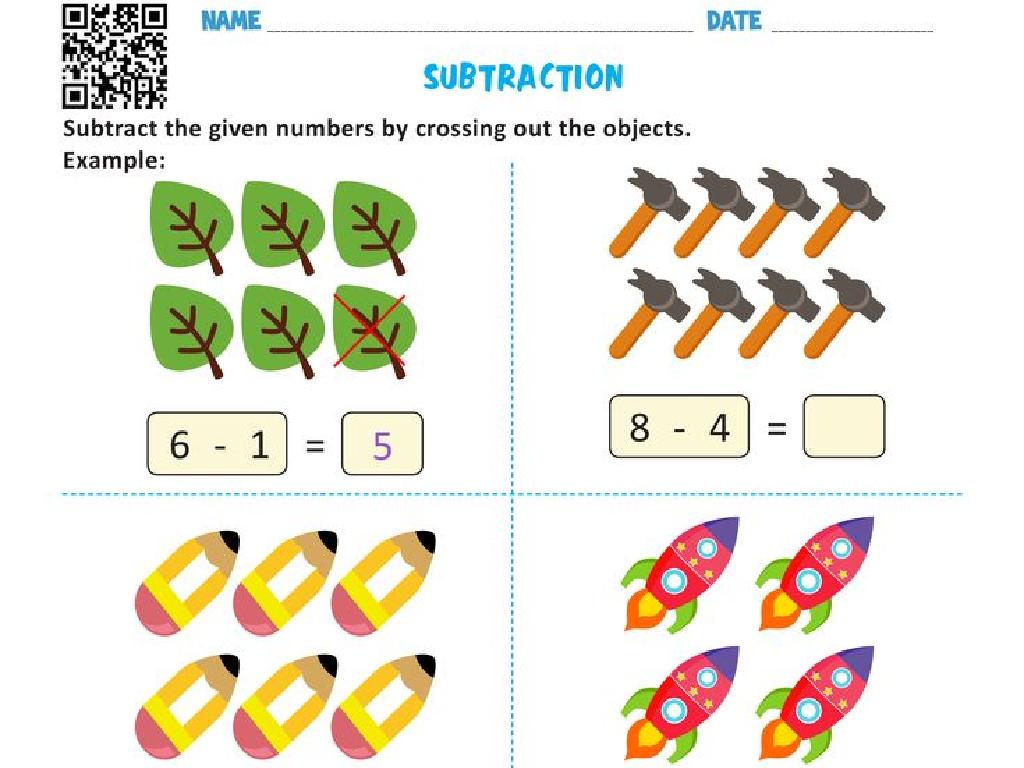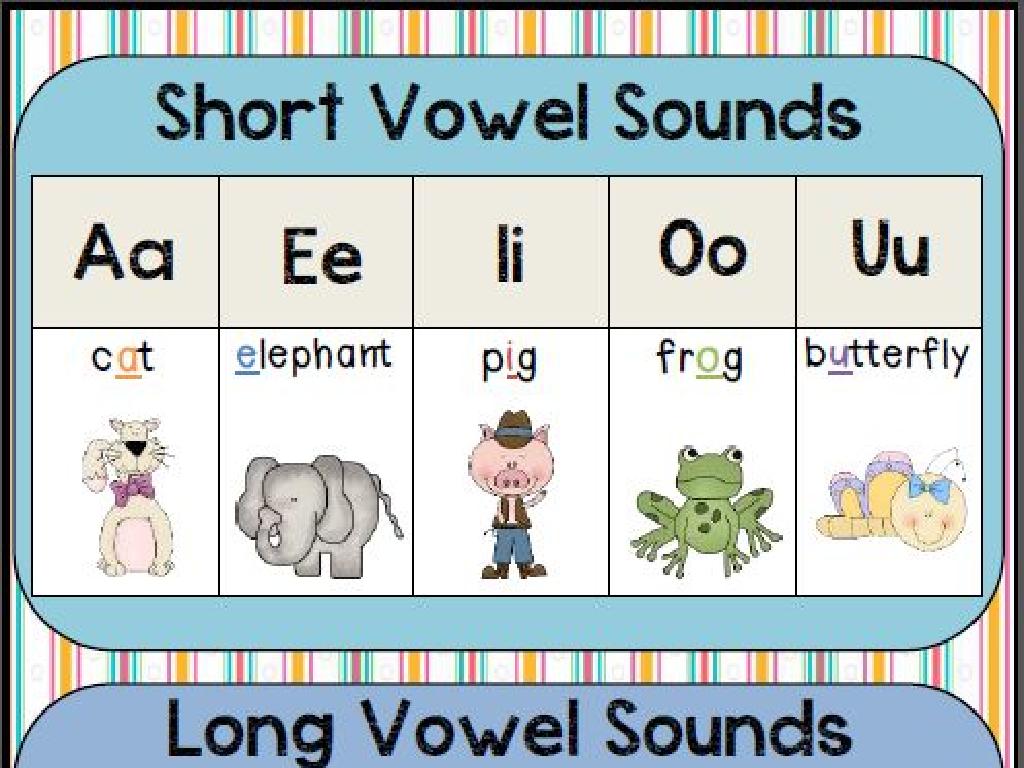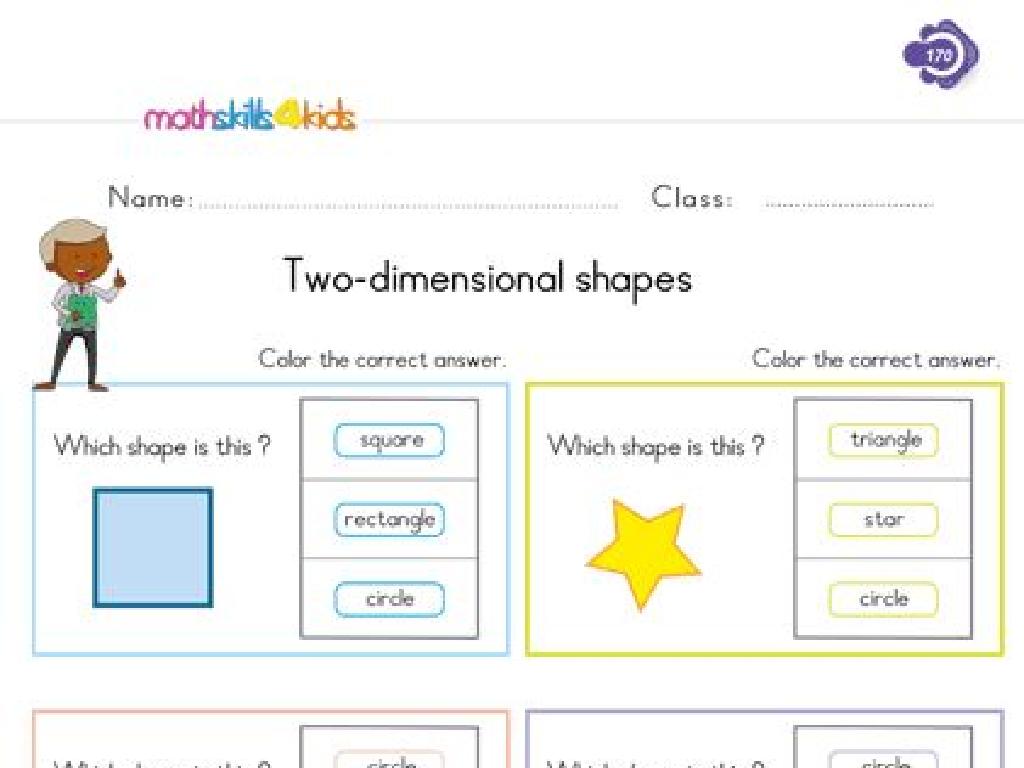Take Apart 10 - Addition Sentences
Subject: Math
Grade: Kindergarten
Topic: Take Apart Numbers Up To 10
Please LOG IN to download the presentation. Access is available to registered users only.
View More Content
Math Fun: Exploring Number 10!
– Greet our young math explorers
– Today’s focus: Playing with 10
– Making 10 in various ways
– For example, 5+5, 6+4, and 8+2 all equal 10
– Fun activities to practice
– We’ll use blocks, drawings, and games to learn
|
Welcome the kindergarteners to the class with enthusiasm to set a positive tone for learning. Today’s lesson is about understanding the number 10 and the different combinations that can be added together to make 10. Use hands-on activities like counting blocks or drawing pictures to show how different pairs of numbers add up to 10. This will help students grasp the concept of addition and number bonds. Encourage participation and make sure to praise their efforts as they explore the various ways to make 10. The goal is to make learning math a fun and interactive experience.
What Makes 10?
– The number 10 is special
– Adding two numbers to make 10
– Like 5 + 5 or 6 + 4
– Discover pairs that equal 10
– We’ll explore different combinations
– Practice with examples
– Try 2 + 8 and 3 + 7 together!
|
This slide introduces the concept of making 10 by adding two numbers. Emphasize the importance of the number 10 as a building block in math. Show students how different pairs of numbers can be combined to total 10. Use visual aids like counters or number lines if possible to help them understand. Encourage the students to think of the number 10 as a friendly number that they can easily work with. During the class, have hands-on activities where students can practice making 10 using different number pairs. This will help solidify their understanding of addition within 10.
Number Pairs for 10
– Many pairs can make 10
– Example: 1 and 9 make 10
– Like puzzle pieces, 1 and 9 fit together to total 10
– Discover other number pairs
– Use your fingers to find different pairs that add up to 10
– Practice with addition sentences
– Write sentences like 2+8=10 to show what you’ve found
|
This slide introduces the concept of number pairs that add up to 10, which is a fundamental building block for understanding addition. Start by showing the example of 1 and 9, and then encourage the students to use their fingers or counters to find other pairs that make 10. This hands-on activity will help them visualize the concept. Have them write down addition sentences for each pair they discover. This exercise will reinforce their understanding of addition and the number 10. During the next class, review the pairs they’ve found and practice creating addition sentences together.
Hands-on Activity: Making 10 with Blocks
– Gather 10 blocks for our activity
– Explore splitting blocks into two groups
– Try splitting them into 5 and 5, or 6 and 4
– Each split represents an addition sentence
– For example, 6 blocks and 4 blocks make 10
– Discover all the ways to make 10
|
This hands-on activity is designed to help Kindergarten students understand the concept of making 10 through addition. Provide each student with 10 blocks and guide them to split the blocks into two groups in various ways. As they do this, help them see that each split is an addition sentence (e.g., 6 blocks + 4 blocks = 10 blocks). Encourage them to find all the different combinations that add up to 10. This activity will help solidify their understanding of addition within 10 and is a foundational skill in early math development. Possible variations for different students could include using different colored blocks, combining the activity with a song, or having students work in pairs to find new combinations.
Making 10 with Addition Sentences
– Addition sentences tell a math story
– Two small numbers make a bigger one
– Example: 4 blocks + 6 blocks = 10 blocks
– Like combining toys: 4 toy cars + 6 toy cars = 10 toy cars
– Practice making 10 with different numbers
– Try 5 crayons + 5 crayons, or 3 stickers + 7 stickers
|
This slide introduces the concept of addition sentences to Kindergarten students by relating it to a story where two smaller groups come together to form a larger group. The example uses blocks, a familiar object to children, to illustrate the concept of combining quantities. Emphasize that addition is simply the process of putting together. Encourage the students to think of other sets of objects they can combine to make 10. During the class, provide various objects for them to physically group together in different combinations to reach 10, reinforcing the concept through hands-on activity.
Let’s Practice Together: The ‘Make 10’ Game
– We’re playing a ‘Make 10’ game
– I’ll show a number, you find the addend
– If I show you 2, what number do we add to make 10?
– What do we add to make 10?
– Finding the missing number to reach 10
– Ready to play and learn?
|
This slide is designed to engage Kindergarten students in a fun and interactive ‘Make 10’ game. The objective is to help them understand addition sentences that sum up to 10. Show a number to the students, and they have to figure out which number to add to it to make 10. This activity reinforces their comprehension of basic addition and the concept of ‘taking apart’ numbers. For the activity, have a set of flashcards with numbers 1-9. Show one card at a time and prompt the students to say or write down the number that needs to be added to make 10. Encourage participation and praise correct answers to build confidence. Possible variations of the activity could include using objects, drawing, or physical activities where students have to group themselves to make 10.
Class Activity: Create Your Own 10
– Draw 10 circles on your paper
– Use two colors for the circles
– Maybe 5 blue and 5 red? Or 6 green and 4 yellow?
– Show different ways to make 10
– Like 7+3 or 5+5, use colors to show each part
– Share your 10s with the class
|
This activity is designed to help Kindergarten students understand the concept of making 10 in various ways. Provide them with paper and crayons or markers. Guide them to draw 10 circles and color them to visually represent addition sentences that sum up to 10. Encourage creativity in how they choose to color the circles. Once they’ve completed their drawings, facilitate a discussion where each student can explain their unique way of ‘taking apart’ and ‘putting together’ the number 10. This will reinforce their understanding of addition within 10 and provide a foundation for future math skills.
Sharing Our Discoveries: Making 10!
– Show your drawings to the class
– Describe your addition sentences
– Explain how you added numbers to get 10
– Discuss different ways to make 10
– Did you find 5+5, 6+4, or 7+3? Any others?
– Celebrate our math exploration
|
This slide is meant for a class activity where students will present their drawings that illustrate different addition sentences summing up to 10. Encourage each student to explain their thought process and how they arrived at the addition sentences. This activity will help students understand that there are multiple combinations that can add up to 10, reinforcing their comprehension of addition within 10. As students share, list their findings on the board to visualize the variety of combinations. Praise their efforts and creativity in finding different ways to make 10. This will also serve as an assessment of their understanding of the concept.
Conclusion and Goodbye: Celebrating Our Math Journey
– Celebrate your hard work
– Many ways to make 10
– Like 5+5, 6+4, or 2+8!
– Math is fun and exciting
– You’re amazing math explorers!
– Keep exploring numbers at home!
|
As we wrap up today’s lesson, it’s important to celebrate the students’ efforts in learning different addition sentences that make 10. Reinforce the concept that math is not just about numbers; it’s a fun adventure of exploration and discovery. Encourage the children to continue practicing at home and to see themselves as capable and enthusiastic mathematicians. This positive reinforcement helps build their confidence and fosters a love for learning math. Remember to give specific praise to students for their participation and achievements during the lesson.





/american_world_power_events.jpg)
